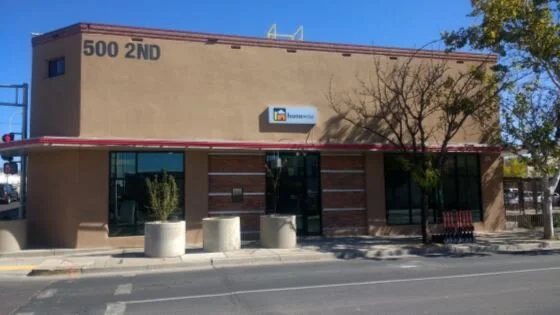The nonprofit lender has already changed the face of Downtown and Barelas. And the organization's big plans are not contingent on the slow process of getting grants.
Sometimes, new neighbors move in quietly, perhaps shake a few hands, and then pretty much keep to themselves for years on end. Others invite the entire block over for parties, make a point of learning everybody's name, show up at the door with banana bread just because, and quickly wind up serving on five different neighborhood association subcommittees.
Homewise, the nonprofit mortgage lender founded in 1986, falls into that last category. It bought the former Orpheum Theater in 2017, pulled off a massive renovation, and over the summer opened it up as a headquarters plus "community hub" with meeting spaces that groups and members of the public can book. It also bought and renovated the B. Ruppe Drugs building on 4th and is currently seeking tenants there. Meanwhile, it's busy identifying local distressed residential properties that would be good candidates for purchasing and fixing up.
Besides real estate ventures, Homewise also appears to be on something of a charm offensive. It hosts First Friday Arts events, recently took a bunch of Barelas neighbors to a New Mexico United game, grows its own hops on site for a special beer served at nearby Sidetrack Brewing, saw to it that a mural dedicated to local history was put up on its north wall along Coal, and even started a blog spotlighting local businesses and organizations.
This much seems clear: Wells Fargo it ain't.
We figured it was high time to learn more about Downtown's new Super Neighbor, so we put together this Q & A guide:
What's the difference between a traditional for-profit mortgage lender and a nonprofit like Homewise?
The organization basically combines the technical and financial services you normally get at banks or other mortgage lenders with the sort of coaching and education that lots of home buyers get informally from friends and family. Between getting your credit score in shape to finding a good real estate agent to doing a proper walk-through to choosing between fixed or adjustable rate mortgages, the home buying process is chalked full of complex challenges that are generally not taught in school. Homewise will walk clients through all of that, and offer down payment assistance to boot.
What sort of people work with Homewise?
Though Homewise takes all comers, Director of Community Development Johanna Gilligan says the organization focuses on people who would have a hard time getting the traditional lending sector to work with them. That includes folks with low credit scores who may need years of coaching and planning before they're ready to buy. It also includes people with fluctuating incomes, like freelancers, and households with an iffy immigration status. (Homewise can work with Individual Taxpayer Identification Numbers, which are issued by the IRS and often used by undocumented immigrants to pay taxes.)
Why are they doing this work?
Helping people make large purchases is likely not the first thing that comes to mind when you think of do-gooder non-profit work, but the idea is to help people achieve the same financial win that a home ownership investment can be for the larger population.
"Home ownership freezes your largest monthly expense," Gilligan says. "Helping these people become homeowners helps to stabilize the community."
Hops grown at Homewise headquarters at 2nd and Coal are used in Orpheum Beer, named for the theater that used to call the building home and served up at nearby Sidetrack Brewing
What does mortgage lending with a heart have to do with fixing up properties in Downtown/Barelas?
Though most of Homewise's 90 staffers are focused on the finance side of the equation, the organization has for a couple of years dedicated a few people to community development, a fancy term for buying distressed properties (usually residential), fixing them up, and selling them. In Albuquerque, they've made a special project of doing so in Barelas and South Broadway, and Gilligan says they'll add another neighborhood to the mix in 2020.
The idea is to sell the fixed up houses to people Homewise was working with anyway, Gilligan says. If they can't find a buyer that way or by putting the word out to neighborhood groups, they'll eventually put it up for sale on the open market.
The goal is to renovate and sell 16 homes per year in the target neighborhoods, which could mean 5-10 homes in Barelas every year, depending on what opportunities crop up on the market.
With all those clients making mortgage payments, Homewise actually has a revenue stream. So how much outside funding does this nonprofit require?
Believe it or not, the answer is none, Gilligan says. The nonprofit does of course accept grants, but they seem to be more of a "nice to have" rather than a "got to have." People paying their mortgages do the heavy lifting to keep the lights on (some departments within the organization, like community development, are subsidized by others). It was a model born of necessity: There just isn't that much in the way of foundation funding in New Mexico, so Santa Fe-born Homewise had to improvise.
It's an idea Gilligan thinks could work well outside of New Mexico: "We think this is a critical way to address the wealth gap in the United States," she said.
What's happening with the B. Ruppe Drugs building now that the big grand opening is done?
The general plan is to have a kind of six-month open house during which people and groups can use it for free. (Reserve it here.) The hope is that this will raise the profile of the place and help with the long-term goal of attracting some kind of healthrelated tenant or tenants to the building, thus keeping with the Ruppe tradition.
How does this work mesh with what the Barelas Community Coalition is doing?
The short answer is that the two groups have pretty different briefs, though there's some potential for overlap. The BCC is generally focused on sprucing up 4th and running the Rail Yards Market, while Homewise buys houses and sometimes commercial properties in the larger neighborhood for fixing up. But representatives of the two groups (and the Barelas Neighborhood Association) all seem to be on friendly terms and often pop up at each other's meetings or in each other's conversations.


